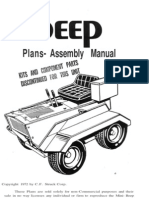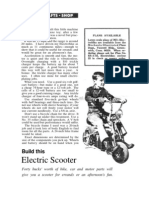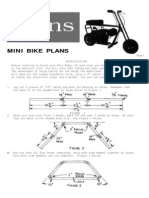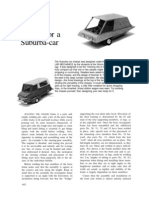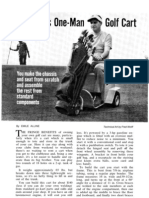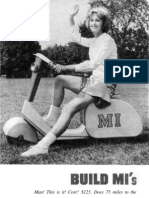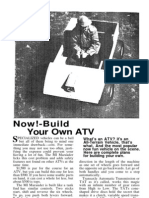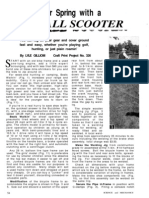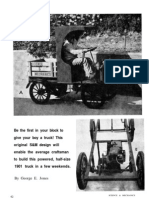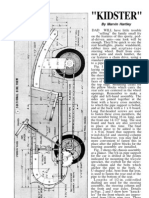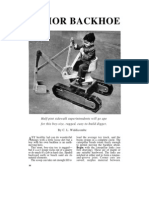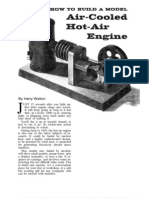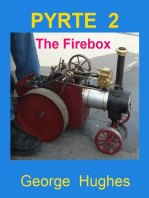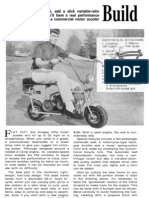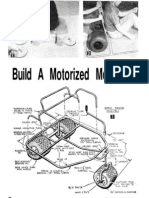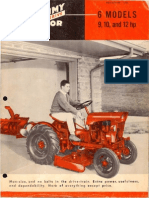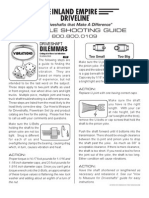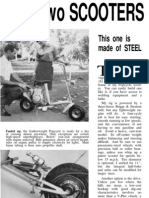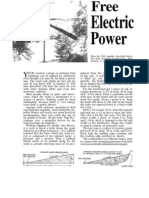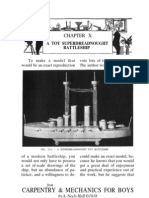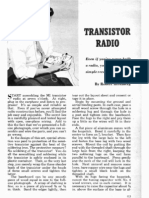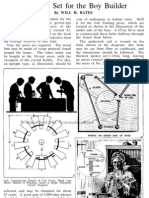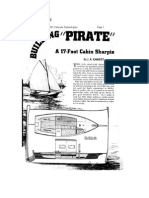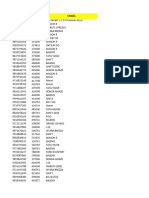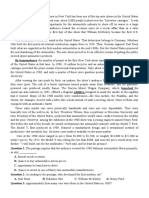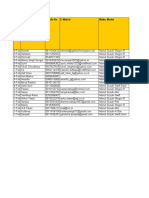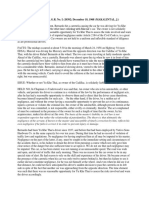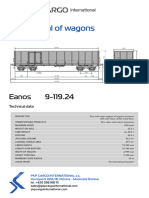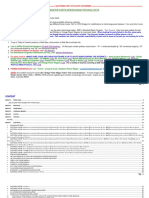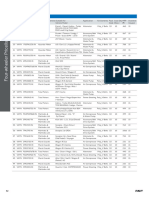Building One Lung Karts
Building One Lung Karts
Uploaded by
JimCopyright:
Available Formats
Building One Lung Karts
Building One Lung Karts
Uploaded by
JimCopyright
Available Formats
Share this document
Did you find this document useful?
Is this content inappropriate?
Copyright:
Available Formats
Building One Lung Karts
Building One Lung Karts
Uploaded by
JimCopyright:
Available Formats
A wealth of practical
ideas about—
Building:
One- Lung
Cars
for K i d s
By Harry Walton
T
OPS in thrills for any youngster is
a car he can drive to the purpose-
ful bark and hot breath of a real
engine. Building such a car is fun for all
hands from the moment you start putting
a one-lunger on wheels.
It can be simple. Boys build them
w i t h a plank for a chassis, a wooden axle
pivoted on a spike for steering, and a
clutchless push-and-hop-on drive. It can
be sophisticated to the point of having
IT'S A FLIVVER, with a
brass-bound radiator, a
klaxon horn, a hand-
rubbed lacquer finish
and tin-lizzy fenders.
Built by Robert Paul
Moore of Tulsa, it has
run 500 miles.
FOR YOUNG PILOTS,
this Air Force jeep built
by Capt. James Sparks
Jr. can haul a trailer,
too. A spring-loaded
reel (under the lever)
pulls idler to maintain
driving-belt tension.
UNDER THE HOOD of the sleek flivver on the that their output shafts turn in opposite direc-
preceding page is a four-hp. engine. Through tions, these drive two clutches on the counter-
chains and a drive shaft, power goes to two shaft. Engaging one clutch sends car forward;
identical right-angle gearboxes. So mounted engaging the other clutch reverses it.
a real gearshift (from a motorcycle or
small car) and spring suspension.
In between there are many ways you
can b u i l d a car that w i l l deliver a lot of
f u n . A l t h o u g h it won't be legal for street
use, there is usually a y a r d or driveway,
a dead-end turnaround or a closed road
youngsters can drive on.
The parts you'll need. Old power mow-
ers are a prime engine source. Look for
trade-ins at mower shops. Rubber-tired
semi-pneumatic wheels w i t h b u i l t - i n ball
or roller bearings are sold by mail-order
houses, surplus dealers, and bicycle
stores. T h e 1.75"-by-8" size w i l l do. Bet-
ter 2.75"-by-10" wheels cost about $5
apiece.
Automatic clutches, pillow blocks,
shafting, drive chains and sprockets are
available from the same sources. Second-
hand parts w i l l serve. D o n ' t overlook
auto wreckers for control cables, brake,
steering and body components.
There are kits, too, ranging from run-
ning-gear parts only, to those that i n -
clude the drive mechanism and even the
engine. Y o u can spend as l i t t l e as $20 or
as much as $300.
What size engine? A speed of 10 m.p.h.
(ample for children) can be attained
w i t h a 3/4-hp. engine. A 2-1/2 hp. engine
w i l l wheel a car at over 25 m.p.h. One
w i t h a horizontal shaft is easier to install
t h a n the vertical-shaft k i n d . (These re-
154 POPULAR SCIENCE
Ideas for a sturdy frame and front axles with real auto steering
HERE ARE SOME WAYS you might b u i l d
the backbone of a car. The one at right,
designed for a front-mounted engine, is
made of 3/4" p l y w o o d . Wooden members
can be joined w i t h drawbolts as in the
drawing. W i t h welding equipment, you
can use angle iron or electrical conduit.
APRIL 1959 |55
DOUBLE DECK OF PLYWOOD on two steel chan- of 13:1. The control lever tightens a flat idler
nels forms the chassis of this kit-built car. Steer- against a belt or, pulled back, clamps a brake
ing is direct from a crank on the shaft. The onto one wheel. Kacy Mfg. Co., Genoa, 111.,
drive, upside down above, takes horizontal- or offers chassis parts shown for $60, or with ply-
vertical-shaft engines. Two countershafts and wood body kit at 885. It runs well on cast-off
chain drive to the wheel have an overall ratio one- to three-hp. mower engines.
156 POPULAR SCIENCE
quire a long belt w i t h a 90-degree twist.)
Checking the throttle action. If an en-
gine has an air-vane governor, you may
want to connect the control cable d i -
rectly to the throttle for quicker response.
R i g a return spring on the throttle arm
so that if the control fails, the engine
w i l l snap back to i d l i n g .
Sizing up the chassis. T h e wheelbase
may be from 4 0 " to 60", the tread from
2 2 " to 30". A short wheelbase turns more
sharply; a longer one makes the drive
easier to arrange, and affords more leg-
room for growing youngsters.
P u t the engine in back to simplify STRICTLY HOMEMADE, this car is the work of
the drive and to add its weight for good young Mike Zingarelli of White Plains, N. Y. It
traction. B u t don't mount it so far back is built on a 3/4"-plywood platform, with a 41"
that it tends to t i l t up the front. wheelbase. A 2" centrifugal clutch on the two-
hp. engine drives a 6" wheel pulley. This low
T h e frame need not be r i g i d ; some ratio is speedy but wears the belt on starts.
flexing compensates for the lack of Mike helps out by pushing, then hops on. He
springs, helping to keep a l l four wheels made a good-looking steering wheel of a baby-
carriage wheel by removing some spokes.
BUILT OF STEEL TUBING, this car comes ready-
made with 1.75"-by-8" wheels at $40, or with
2.75"-by-10" wheels at $50. It has automotive
steering and a brake acting on both rear wheels.
Rocco Products, Inc., Minneapolis, Minn., offers
drive kits for it less motor for $20 and $30, with
motor at $70 and $90. Rack-and-pinion steering
can be added to the assembly for $10, and
snow runners for an additional $8.
APRIL 1959 157
on the ground. Wood makes a satisfactory
frame requiring only common tools.
Auto-type steering can be improvised
from hinges, scrap iron or even pipe fit-
tings, as shown. Angle the steering
knuckles inward. T h i s maintains correct
radius in turns. H o l d wheels on w i t h
husky cotter pins or by clamping the i n -
ner bearing race tight w i t h a nut on a
threaded spindle bolt.
The simplest steering w i t h a step-down
ratio is the drum-and-cable type. T h e
d r u m must be concentric w i t h the shaft A DRILL-PRESS SPEED CHANGER ( t o p left) or the
and pinned to it. Use the 3/32" steel cable similar device near it makes a compact variable-
and end clips sold for power-boat tillers. ratio drive. These shift one belt to a smaller, the
other to a larger diameter as the lever is moved.
Brakes are a must. For modest speeds Automatic clutches shown are (left) mercury
and level ground, a single one on the and (right) centrifugal types.
nondriving wheel suffices. L i n e wooden
brake shoes w i t h machine belting or tire
tread. See that brakes release f u l l y .
How to rig a drive. W i t h an engine of
two hp. or more, a single reduction of one
to six or seven w i l l r o l l the car too
fast for children. An overall ratio of 10,
11 or even 13 is safer.
Drive one wheel only. Y o u can key it
to the axle, mounted in pillow blocks,
and drive the axle, but it is simpler to
fasten a " d e a d " axle solidly, let both
wheels t u r n on it on their own bearings,
and bolt the drive pulley on one.
To center a pulley or sprocket having
a hole bigger than the axle, d r i l l bolt
holes oversize and mount the pulley w i t h
the nuts finger-tight. Spin the wheel on
the axle to detect run-out. T a p the pulley
or sprocket one way or the other u n t i l it
runs dead true. T h e n tighten the nuts.
Be sure to mount the engine to drive
forward. Pipe the exhaust downward and
shield hot parts. Hang countershafts in
pillow blocks or oilite bushings. W i t h
sprung rear axles, the countershaft must
be so mounted as to m a i n t a i n a constant
distance between the drive pulleys.
A stepless ratio shift can be had w i t h
a transmission pulley. N o t to be confused
w i t h an automatic clutch, this forces the
belt to ride on a greater diameter as
speed goes up. A spring-loaded idler or
swinging countershaft is necessary to
keep the belt taut.
Cut paper patterns as guides in shap-
ing sheet a l u m i n u m or galvanized iron
over the body. O l d auto fenders can be
cut down for parts requiring difficult
compound curves. M e t a l plasterer's lath
makes a neat radiator grille.
158 POPULAR SCIENCE
BOXED-IN ENGINE of Capt. Sparks' jeep drives SLICKLY PROFESSIONAL is this two-step reduc-
a jackshaft extending over the drive wheel. The tion drive engineered by V-Plex Clutch, of
rear axle is mounted on half lengths of auto leaf Hagerstown, Ind. The jackshaft turns in a tubu-
springs. Spring-tensioned idler keeps the belt lar crosspiece mounted on one frame member.
taut. Pushed forward, the control tightens a As the engine revs up to 1,800 r.p.m., the
band brake on the other (nondriven) wheel. centrifugal clutch engages the belt. END
APRIL 1959
You might also like
- Tom Thumb Mini BikeDocument4 pagesTom Thumb Mini Bikemysteriousracerx100% (7)
- O Livro de Ouro Dos Experimentos Químicos (RARIDADE)Document114 pagesO Livro de Ouro Dos Experimentos Químicos (RARIDADE)Davidson De Oliveira Lima100% (1)
- Autodesk Vehicle Tracking Introduction PDFDocument13 pagesAutodesk Vehicle Tracking Introduction PDFCool BluesNo ratings yet
- Ford Taurus 1996Document79 pagesFord Taurus 1996Mac PirxNo ratings yet
- King Midget ArticleDocument8 pagesKing Midget ArticleJim100% (11)
- Pedal Car Plans 01Document5 pagesPedal Car Plans 01Amy Reed86% (7)
- Beep Plans CompleteDocument9 pagesBeep Plans Completetaxmac80% (5)
- Electric Scooter PlansDocument6 pagesElectric Scooter PlansJim88% (8)
- Yard-Dozer MidgetDocument5 pagesYard-Dozer MidgetOlin Stej83% (6)
- CAR BIBLE SuspensionDocument10 pagesCAR BIBLE SuspensionMohd Sharuddin100% (2)
- Electric Scooter PlansDocument6 pagesElectric Scooter PlansJim88% (8)
- Star Lite SailboatDocument13 pagesStar Lite SailboatJim100% (10)
- Mineral Vegetable and Animal LifeDocument4 pagesMineral Vegetable and Animal LifeJim86% (7)
- The Boy's Book of Crystal SetsDocument36 pagesThe Boy's Book of Crystal SetsJim100% (10)
- ElectroscopeDocument1 pageElectroscopeJimNo ratings yet
- Wren Minibike PlansDocument7 pagesWren Minibike PlansJim100% (5)
- History of The Automobile - The Brands PDFDocument177 pagesHistory of The Automobile - The Brands PDFfiat127sport100% (1)
- Maytag RoadsterDocument5 pagesMaytag RoadsterJim100% (3)
- Midget Sports CarDocument7 pagesMidget Sports CarJim100% (8)
- Suitcase PowercycleV2Document13 pagesSuitcase PowercycleV2Jim67% (3)
- Suburba Car, Chassis For ADocument7 pagesSuburba Car, Chassis For AJim100% (9)
- By Emile Alline: Technical Art by Fred WolffDocument4 pagesBy Emile Alline: Technical Art by Fred WolffJim100% (3)
- Midgettractor PSMar 54Document7 pagesMidgettractor PSMar 54JimNo ratings yet
- 3 Wheel Dune BuggyDocument5 pages3 Wheel Dune BuggyyukitadaNo ratings yet
- Plywood ScooterDocument7 pagesPlywood ScooterJim100% (4)
- Six Wheeled ATV by Mechanix IllustratedDocument7 pagesSix Wheeled ATV by Mechanix IllustratedJim100% (6)
- Brush Buggy, Build An ExcitingDocument5 pagesBrush Buggy, Build An ExcitingJim88% (8)
- PowerCycle With SideCarDocument7 pagesPowerCycle With SideCarJim100% (2)
- Tote All ScooterDocument7 pagesTote All ScooterJimNo ratings yet
- Vintage Power Tool Plans 1950sDocument180 pagesVintage Power Tool Plans 1950sPierre799es100% (6)
- 1901 TruckDocument10 pages1901 TruckGary B. Watts100% (3)
- Membuat Mini Bike Mesin KompresorDocument8 pagesMembuat Mini Bike Mesin Kompresormawan_jogjaNo ratings yet
- Vintage Farm Impliment Plans 1950sDocument91 pagesVintage Farm Impliment Plans 1950sudivljini100% (4)
- Mite Cycle by Mechanix IllustratedDocument7 pagesMite Cycle by Mechanix IllustratedJim100% (3)
- Pedalmatic 1951Document3 pagesPedalmatic 1951Jim100% (4)
- Homebuilt Wood CarDocument26 pagesHomebuilt Wood Carsjdarkman1930100% (3)
- Vintage Playground Plans 1950s PDFDocument39 pagesVintage Playground Plans 1950s PDFAlexandre Mello100% (1)
- Homemade Bandsaw From Pipe Fittings and Auto PartsDocument4 pagesHomemade Bandsaw From Pipe Fittings and Auto PartsJan Steinman100% (2)
- Car 1901packardDocument8 pagesCar 1901packardDillon Hartsyker100% (1)
- Midget Tractor PlansDocument6 pagesMidget Tractor Plansmtullius1234No ratings yet
- Diy Kart Plans - Electric CarDocument8 pagesDiy Kart Plans - Electric CarzaoioazNo ratings yet
- Air Cooled Hot Air EngineDocument6 pagesAir Cooled Hot Air EngineJim50% (2)
- Bandmill PlanDocument14 pagesBandmill Planpaulh1965100% (1)
- Super Scooter by Mechanix IllustratedDocument12 pagesSuper Scooter by Mechanix IllustratedJim100% (3)
- How to Build a Children's Swing, Slide, Roundabout and Toboggan for the Garden - An Illustrated GuideFrom EverandHow to Build a Children's Swing, Slide, Roundabout and Toboggan for the Garden - An Illustrated GuideNo ratings yet
- Model Racing Yachts - Being No. 6 of the New Model Maker Series of Practical Handbooks Covering Every Phase of Model Building and Design - With 90 Illustrations Including 12 Practical Working DesignsFrom EverandModel Racing Yachts - Being No. 6 of the New Model Maker Series of Practical Handbooks Covering Every Phase of Model Building and Design - With 90 Illustrations Including 12 Practical Working DesignsRating: 4 out of 5 stars4/5 (1)
- Fat-Tire Scooter For SportsmenDocument5 pagesFat-Tire Scooter For SportsmenFrenchwolf420100% (1)
- Bicycle MinibikeDocument6 pagesBicycle MinibikeJim100% (1)
- Build MI's Tornado!: by John CapotostoDocument3 pagesBuild MI's Tornado!: by John CapotostoJim100% (1)
- 3 Wheel Go KartDocument5 pages3 Wheel Go KartLucas BrasilNo ratings yet
- Build Mechanics Illustrated KartDocument7 pagesBuild Mechanics Illustrated KartJim100% (5)
- Midget Tractor3 PlansDocument6 pagesMidget Tractor3 PlansDanilo RochaNo ratings yet
- Sidewalk Play Car: by Elmer V. ClarkDocument5 pagesSidewalk Play Car: by Elmer V. ClarkJimNo ratings yet
- 3 Wheel 2Document5 pages3 Wheel 2jii_907001No ratings yet
- Vintage Go Kart Mini Bike Plans-1950sDocument95 pagesVintage Go Kart Mini Bike Plans-1950sJanne FredrikNo ratings yet
- ScooterDocument7 pagesScooterBuyuangKota100% (1)
- 1965 Sales BrochureDocument14 pages1965 Sales Brochurerwesseldyk100% (1)
- Popular Mechanics - Replacing U-JointsDocument4 pagesPopular Mechanics - Replacing U-JointsGeorgiana MarinNo ratings yet
- Gokart Project ReportDocument18 pagesGokart Project ReportSudhir RojeNo ratings yet
- Dilemmas: Trouble Shooting GuideDocument3 pagesDilemmas: Trouble Shooting GuideCosmicdancer RudraNo ratings yet
- Jawa 638.5Document3 pagesJawa 638.5api-3773885100% (1)
- Wooden Scooter and PopcycleDocument6 pagesWooden Scooter and PopcycleJim75% (4)
- SteerDocument6 pagesSteernehascribd1No ratings yet
- Load-Equalizing Trailer Hitch You Can Make IDocument4 pagesLoad-Equalizing Trailer Hitch You Can Make IFrenchwolf420No ratings yet
- Breeze Baby Sailboat PlansDocument5 pagesBreeze Baby Sailboat PlansJim100% (5)
- Bull Frog Go KartDocument15 pagesBull Frog Go KartJim100% (3)
- Free Electric Power WindmillDocument3 pagesFree Electric Power WindmillJim100% (4)
- Dorothy 24 Foot Sailing CruiserDocument11 pagesDorothy 24 Foot Sailing CruiserJim92% (12)
- Magnetic Current PamphletDocument9 pagesMagnetic Current PamphletJim100% (2)
- Candle Powered EngineDocument2 pagesCandle Powered EngineJimNo ratings yet
- Model Hot Air EngineDocument4 pagesModel Hot Air EngineJim100% (4)
- Air Cooled Hot Air EngineDocument6 pagesAir Cooled Hot Air EngineJim50% (2)
- Super Scooter by Mechanix IllustratedDocument12 pagesSuper Scooter by Mechanix IllustratedJim100% (3)
- Radio SimplifiedDocument94 pagesRadio SimplifiedJim100% (3)
- Magnetic BaseDocument3 pagesMagnetic BaseJim100% (2)
- Listening LoopsDocument2 pagesListening LoopsJim75% (4)
- War Toys For BoysDocument48 pagesWar Toys For BoysJim100% (2)
- Vintage Transistor RadioDocument4 pagesVintage Transistor RadioJim100% (1)
- Space Age Crystal SetDocument3 pagesSpace Age Crystal SetJim100% (3)
- Crystal Radio LampDocument4 pagesCrystal Radio LampJim100% (2)
- Flashlight RadioDocument5 pagesFlashlight RadioJim67% (3)
- A Crystal Set For The Boy BuilderDocument3 pagesA Crystal Set For The Boy BuilderJim100% (4)
- Receive Short W A V E Onyour HomeradioDocument5 pagesReceive Short W A V E Onyour HomeradioJim100% (9)
- Vintage Transistor RadioDocument4 pagesVintage Transistor RadioJim100% (1)
- Build A Scintillometer Uranium Detector For ProspectingDocument11 pagesBuild A Scintillometer Uranium Detector For ProspectingJim80% (5)
- Build Pirate A 17 Foot Cabin SharpieDocument6 pagesBuild Pirate A 17 Foot Cabin SharpieJim100% (3)
- Coil Winding MachineDocument4 pagesCoil Winding MachineJim90% (10)
- Historical Background of Land TransportationDocument59 pagesHistorical Background of Land TransportationDavie Jane Pascua100% (1)
- Conversion of Different Vehicles Counted: Vehicle Total Counts PCE PCU % of Total PCUDocument1 pageConversion of Different Vehicles Counted: Vehicle Total Counts PCE PCU % of Total PCURaisul Islam SunnyNo ratings yet
- Commodore VIN Decoder (VB To ZB)Document10 pagesCommodore VIN Decoder (VB To ZB)scottandsarahcarrNo ratings yet
- Data 2019 2100 Entry CarDocument88 pagesData 2019 2100 Entry Caractivesenterprises2015No ratings yet
- Willys Identification TagsDocument11 pagesWillys Identification Tagsextasia2No ratings yet
- Model Q. PaperDocument2 pagesModel Q. PaperSAMKIT SHAHNo ratings yet
- Passage 10Document4 pagesPassage 10Lily NguyenNo ratings yet
- Zig WheelsDocument2 pagesZig Wheelsvivekagrawal11783No ratings yet
- 2013 - FprEN - Fahrtechnik - Gueterwagen - Ausnahmen - 14363 EnglishDocument87 pages2013 - FprEN - Fahrtechnik - Gueterwagen - Ausnahmen - 14363 EnglishSuat SayimNo ratings yet
- 2018-06-01 Classic Land RoverDocument100 pages2018-06-01 Classic Land Rovergufff100% (1)
- Policy NewDocument3 pagesPolicy NewShubhamNo ratings yet
- Railteco Group: Railway Wagon & Bogie ManufacturerDocument52 pagesRailteco Group: Railway Wagon & Bogie ManufacturerJose RodriguezNo ratings yet
- Issue111 - Hornby Club Magazine - Spring 2017Document52 pagesIssue111 - Hornby Club Magazine - Spring 2017kamikaze.thunderboltNo ratings yet
- DERAILMENT Causes - DR Rajiv DesaiDocument145 pagesDERAILMENT Causes - DR Rajiv Desaiinfo.dexmechNo ratings yet
- Saadiq Auto Finance Pricing: New VehiclesDocument2 pagesSaadiq Auto Finance Pricing: New VehiclesNedian Sarfaraz Ahmed ShaikhNo ratings yet
- Maruti SuzukiDocument43 pagesMaruti SuzukiOwais Kadiri100% (1)
- Tyres For Transport Machines Procedure For Determining Inflation PressuresDocument1 pageTyres For Transport Machines Procedure For Determining Inflation PressuresThiago Lisboa GuimarãesNo ratings yet
- New Price List W.E.F. 13-May-2024 - LKODocument6 pagesNew Price List W.E.F. 13-May-2024 - LKOAshwin singhNo ratings yet
- #3 Caedo vs. Yu Khe ThaiDocument1 page#3 Caedo vs. Yu Khe ThaiJanine AranasNo ratings yet
- Inclined PlanesDocument5 pagesInclined PlanesGrace BruanNo ratings yet
- Eanos 9-119.24-AnglDocument1 pageEanos 9-119.24-AnglltgcargopolskaNo ratings yet
- History of ChevyDocument16 pagesHistory of ChevyZaheer KhanNo ratings yet
- Drive ShaftDocument52 pagesDrive ShaftManny AnacletoNo ratings yet
- Commercial VehiclesDocument17 pagesCommercial VehiclesHarshdeepsinh Padhiyar100% (1)
- Dodge Interchange Parts ListDocument325 pagesDodge Interchange Parts ListArmoured CompNo ratings yet
- WWW - Jhbtruckhire.co - Za Rates - PHPDocument1 pageWWW - Jhbtruckhire.co - Za Rates - PHPMike MatshonaNo ratings yet
- Split 44-58Document15 pagesSplit 44-58RAUSHANNo ratings yet






